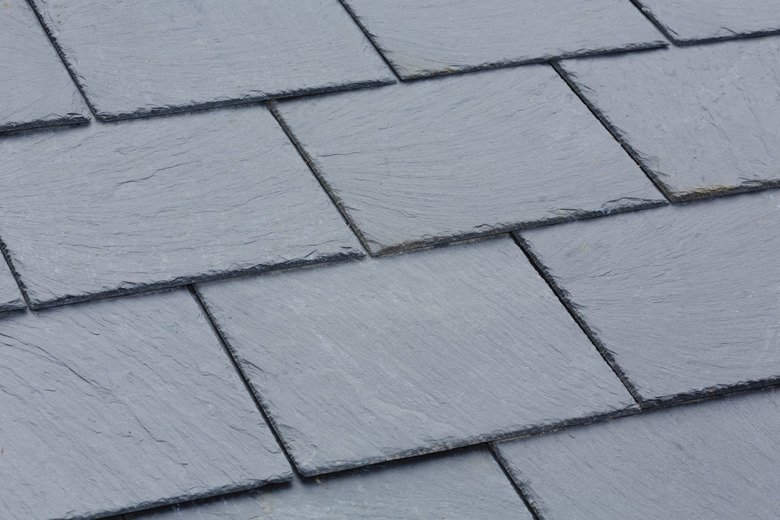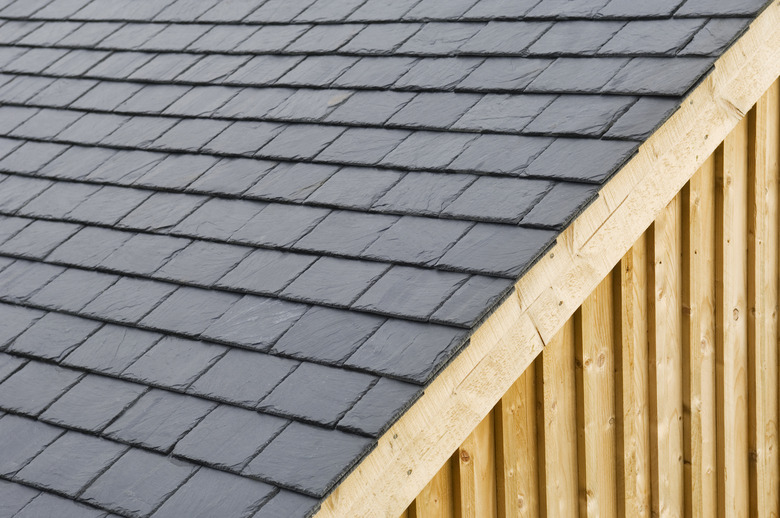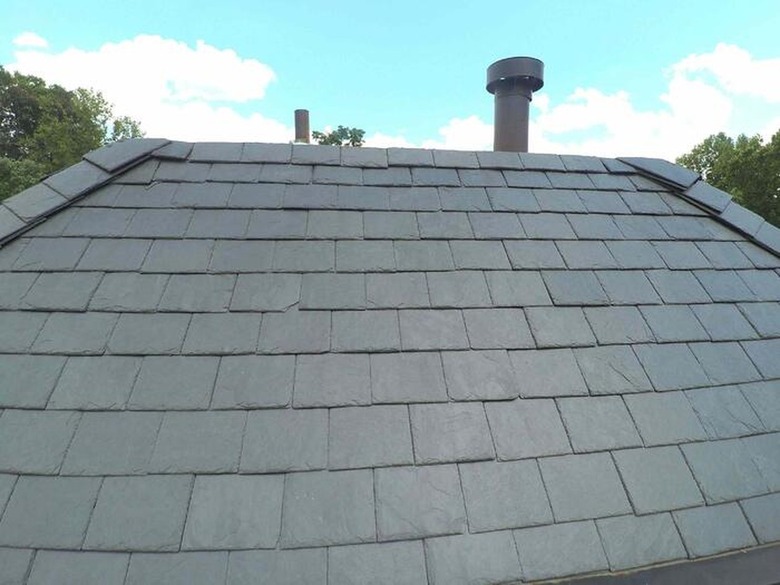Natural Slate Shingles: A Cost And Buyer's Guide
We may receive a commission on purchases made from links.
Are you considering a roofing upgrade to natural slate shingles? Having slate shingles installed is a home improvement project that gives your curb appeal a major boost with a tried-and-true roofing material that adds a stately look to your home. However, there are drawbacks to consider with elegant slate that might make some homeowners reconsider their roofing options.
Types of Slate Shingles
Types of Slate Shingles
Slate shingles are available in either soft slate or hard slate. Both options are long-lasting, often with a life span of over 100 years with proper care. However, soft slate tiles aren't quite as durable as hard slate tiles, and hard slate shingles give you the greatest protection against fire and moisture.
Soft slate shingles are usually significantly cheaper than hard slate, sometimes about half the cost. The type of slate can also impact the color. Most black shingles are made of soft slate, while other colors are usually made from hard slate.
Styles and Looks
Styles and Looks
If you think all slate roofs look the same, you might be surprised to learn about the different styles and looks you can get. Color is the first variation to consider. You can often find slate in black, gray, red, green, and purple as well as mottled shingles with a mix of colors.
The shape, size, and thickness of the stone shingles also affect the appearance. Style options include:
- Uniform slate roofs: A standard slate roof features shingles that are all the same size, shape, and color. Your roofer will install them horizontally with the vertical joints alternating on the courses.
- Patterned slate roofs: If you want a unique look, you might choose a few different colors of slate tiles and have them arranged in a unique pattern. You can also choose slate shingles in different shapes other than the standard rectangle.
- Multicolored slate roofs: You can also use different colors of shingles in a random pattern instead of arranging them in an organized pattern. This method usually incorporates between two and four colors installed randomly across the roof.
- Random-width slate shingles: Another way to vary the look is to install slate shingles of varying widths, either the same color or multiple colors. The length and thickness of all shingles are the same, but the varying widths create a less structured look than the uniform installation.
- Graduated-length slate shingles: Before uniform slate shingles were readily available, they often came in different lengths and widths. The graduated-length arrangement replicates the look of those older roofs. The wider and longer shingles typically go along the eaves near the gutters. The shingles gradually get narrower and shorter as you work toward the top. Some slate roofs use shingles of varying thicknesses, also with a graduated design, with the thickest shingles going near the eaves.
- Textural slate: If you prefer a more rustic, old-fashioned look, a textural slate roof is an option. The slate shingles are often rougher and come in all different thicknesses and sizes. They're arranged randomly on the roof instead of using the graduated approach to create a lot more variation in the texture.
Cost of Slate Shingles
Cost of Slate Shingles
Just like slate floor tiles are more expensive than other materials, slate roofing is also one of the most expensive options. The average cost to install a slate roof is $14,979, but it can cost up to $44,000 or more. On average, soft slate roofing costs $10 to $20 per square foot, and the more expensive hard slate runs $20 to $30 per square foot. About $5 to $15 is the cost of the shingle with an additional $5 to $15 going to labor costs.
Other factors can also impact the price of a slate roof. Anything that increases the difficulty of the installation will likely raise the labor costs. Some factors include:
- Roof pitch: A steep roof makes the slate installation job much more difficult and will likely increase the labor costs at least a little.
- Roof tear-off: You'll need your old roof torn off before having the slate installed. If your roofer handles this task, expect to pay another $2 to $5 per square foot plus disposal fees, which can vary.
- Structural reinforcement: You'll likely need additional reinforcements for heavy slate roofing. This adds to the material and labor cost.
- Roof height: If your home is tall, it makes safe roof work more challenging. Your installer might charge more because of this.
- Roof features: A home with a complicated roofline will often cost more to redo. It takes more time for the roofers to install the slate on a complex roof with lots of features and different sections. Expect to pay more for the complicated work.
The best way to determine if slate is within your budget is to get a customized quote from a roofing company. Ensure the company is experienced with slate so it knows what its doing and can give you an accurate quote.
Life Span of Slate Shingles
Life Span of Slate Shingles
When you have slate shingles professionally installed by an experienced roofing contractor, they could last 50 to 100 years or longer. It's usually the longest-lasting option if you take care of it well. In comparison, asphalt shingles typically last 20 to 30 years, wood shakes last about 30 years, and metal roofs usually last about 50 years.
Most roofing includes a manufacturer's warranty, but slate is a natural material rather than a manufactured roofing material. Your slate roofing might come with a quarry warranty that could be up to 100 years. There should also be a workmanship warranty that covers the roofing company's work for a certain number of years. Roofing warranties might not transfer to the next owner if you move, or they might only transfer through one sale.
Wind and Hail Resistance
Wind and Hail Resistance
Slate shingles can last decades, but they're also brittle and can break under impact. Laboratory testing guided by the National Slate Association showed that S-1 rated natural slate at 3/8 inch thick was rated at class 4, the highest rating. This classification required it to withstand 2-inch ice balls hitting it at 76 miles per hour. At 1/4 inch thick, the slate withstood 1 3/4-inch ice balls at 69 miles per hour for a class 3 rating.
Wind damage to slate is less likely than it is to lighter materials, like asphalt shingles, because of the weight and low profile. However, if the fasteners holding the slate shingles in place are corroded, some of the shingles could blow off the roof. Wind can sometimes cause chatter on steep roofs, which means the slate tiles bang together. This can cause damage if the shingles are already deteriorating or damaged.
In high-wind areas, a 4-inch headlap can help reduce the risk of wind damage. Using 3/4 inch or thicker solid wood sheathing and using the correct nail length can also help improve the wind resistance of slate roofs.
Shingle Fire Resistance
Shingle Fire Resistance
Since it's made out of stone and is noncombustible, slate roofing is fireproof and has a class A fire rating. That means a stray spark from a wildfire, fireworks, or other sources won't start the roof on fire. Keep in mind that this fire resistance doesn't completely prevent your home from catching on fire. A fire inside your home can still destroy it, and the heat could get so intense that it cracks the slate tiles.
Slate Shingle Installation Considerations
Slate Shingle Installation Considerations
Installing slate shingles is more complicated than other roofing materials. That makes it crucial to hire a roofer with slate experience. The shingles can break easily, so the roofer needs to know how to cut and nail them carefully to avoid damage. If the slate isn't installed properly, it won't protect the sheathing and can cause major roof damage.
The weight of slate is another installation issue. A square of slate roofing, which covers 100 square feet, can weigh 800 to 1,500 pounds. Your roofing system might need additional support to hold the slate.
Pros and Cons
Pros and Cons
Like all roofing material options, slate shingles have unique features that can be either advantages or disadvantages. Looking at both helps you decide if the positives are enough to outweigh the drawbacks of installing slate roof shingles.
Some advantages of slate shingles include:
- Natural beauty: Slate tiles lend upscale, natural beauty to your home. You can't come close to the same look with typical asphalt shingles. There might not be as many color and style choices as with asphalt shingle roofing, but a slate roof still allows homeowners to choose different colors, thicknesses, and sizes to customize the look.
- Insulation: Dense, hard slate creates an insulating effect on your roof. It can keep both hot and cold air from passing through the roofing, which can increase home comfort and reduce your need for heating and cooling.
- Increased home value: Installing a slate roof can significantly increase your home's value, especially if you're upgrading from basic asphalt roofing. The longevity and beauty of the roofing are two reasons for the boost in value.
- Longevity: Slate roofing is the longest-lasting roofing material when you care for it properly, which means you won't have to scrape together money to redo it in a few decades.
- Reduced environmental impact: Because they last so long, slate shingles are an eco-friendly option.
- Protection against damage: Slate resists insects, mold, and mildew, which can protect your home from above.
Consider the disadvantages that could influence your decision on a real slate roof:
- Difficult installation: If you choose slate roof tiles, you need a roofing contractor who is highly experienced with slate building materials. It's not a DIY job, and many roofing companies aren't even qualified to do it because of the difficult installation.
- Excess weight: Asphalt usually weighs significantly more than other roofing materials. Asphalt usually weighs 275 to 325 pounds per square, wood shingles usually weigh 300 to 400 pounds per square, and steel standing seam roofing weighs in at around120 to 150 pounds. The 800 to 1,500 pounds per square for slate can stress your roofing structure or require reinforcements that you don't need for other materials.
- Risk of breaking: While slate lasts a long time when properly installed and well maintained, it's also susceptible to breakage due to its rigidity. It doesn't always have the same durability as other roofing options because of this. While it should hold up to things like hail, your slate roof can break if you walk on it the wrong way. That's why it's best to leave any roof work to an experienced professional who knows how to avoid breaking the tiles.
- Cost: For many people, the high cost compared to other roofing material options is a major disadvantage for slate.
Real Slate vs. Synthetic Slate
Real Slate vs. Synthetic Slate
With so many roofing products available, it's no surprise that you can choose a synthetic slate roof instead of real slate. When you choose real slate tiles, you get natural tiles cut from stones. A synthetic slate roof uses plastic and rubber, sometimes recycled and sometimes virgin materials, to mimic the look of real slate. They're typically made in molds that come from real slate tile and are often manufactured with chisel marks and other details to make them look real.
Synthetic slate is a cheaper, lighter option that's easier to install than real slate. While it still has a long life span, it won't last as long as real slate. The quality can also vary significantly. High-end synthetic slate shingles are more likely to look real, whereas cheaper options are easy to spot as imposters. However, from the ground, you might not notice a huge difference, and the synthetic might be close enough to get the look you want. Look at both options in person and check out several synthetic options to find one that looks attractive to you.
References
- Stay Dry Roofing: The Complete Guide to Slate Roofing
- Bill Ragan Roofing Company: Slate Roof vs. Synthetic Slate Roof (The 4 Main Comparisons)
- National Slate Association: Types of Slate Roofs
- Huber & Associates: Things to Consider When Buying a House With a Slate Roof
- Rapid Roofing: Average Life Spans of Different Roofing Materials
- HomeAdvisor: How Much Does It Cost to Install a Slate Roof?
- National Slate Association: Natural Slate Hail Testing: Impact Resistance of Natural Slate Confirmed
- International Association of Certified Home Inspectors: Mastering Roof Inspectors: Mastering Roof Inspections: Slate Roofs, Part 12


